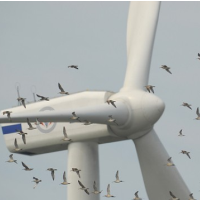No Federal Prosecution if Wind Turbine Kills Endangered Condor
 Birds (not condors) and wind turbine (photo: Chia-Yang (John) Tsai, Changhua Coast Conservation Action)
Birds (not condors) and wind turbine (photo: Chia-Yang (John) Tsai, Changhua Coast Conservation Action)
Air is the natural habitat for California’s ancient, endangered wild condors. They can soar on wind currents for hundreds of miles, barely moving their wings, and since being saved from extinction by an unprecedented 20-year-old breeding program have increased their numbers and expanded their range.
And that’s a problem—a problem that sets environmentalist against environmentalist as the resurgence of condors threatens to impair the development of a wind power, a promising alternative to carbon-based energy sources.
On Friday, the U.S. Bureau of Land Management (BLM) announced for the first time that it wouldn’t prosecute a wind farm developer if a condor dies in the blades of one its turbines. But it only gets to kill one condor over the project’s expected 30-year life.
In giving one free pass to Alta Windpower Development, a subsidiary of Terra-Gen Power, it set a standard for what constitutes reasonable measures to protect the birds that has alarmed their protectors.
“The California condor is a flagship species of the Endangered Species Act,” Kelly Fuller, wind campaign coordinator for the American Bird Conservancy, told the Los Angeles Times. “If taking a condor is allowed, what won’t be allowed?”
That could be tested when the turbines are at full power, supplying electricity for 45,000 homes and a second condor gets zapped.
The 153-megawatt project on 2,300 acres near the town of Mojave is said to be outside the range of condors, with wind drafts supposedly not conducive to fly-bys. Terra-Gen has proposed a warning system attuned to radio transmitters worn by many of the birds, and radar, which would allow for the slowing of the turbines if condors approach.
Federal law prescribes a year in prison and a $100,000 fine for any individual that kills a condor, and a $200,000 fine for an organization that does it.
There are an estimated 132 condors (pdf) left in the California wild. By the time the last wild condor was captured in 1987, the world population had fallen to 22. Development projects, pesticides and lead poisoning from eating the flesh of animals shot by hunters using lead bullets were the primary culprits. All the remaining condors were captured in an effort to save the species and in 1992, they were reintroduced into the wild in California, Arizona and Baja, Mexico.
Earlier projections of where condors might fly are being reassessed as the bird population increases. According to Forbes, U.S. Fish and Wildlife Service studies between 2005 and 2010 show a marked increase in condor range, with encroachment on potential wind turbine sites likely.
–Ken Broder
To Learn More:
Terra-Gen Gets OK on Wind Farm in Wake of Condor Decision (by Louis Sahagun, Los Angeles Times)
Turbine Plans Unnerve Fans of Condors in California (by Felicity Barringer, New York Times)
Revival of Iconic California Condor Threatens State's Wind Farm Boom (by Todd Woody, Forbes)
It’s an “Epidemic”: Hunters Inadvertently Bag Condors with Spent Ammo (by Ken Broder, AllGov California)
Alta East Wind Project (Bureau of Land Management)
- Top Stories
- Controversies
- Where is the Money Going?
- California and the Nation
- Appointments and Resignations
- Unusual News
- Latest News
- California Forbids U.S. Immigration Agents from Pretending to be Police
- California Lawmakers Urged to Strip “Self-Dealing” Tax Board of Its Duties
- Big Oil’s Grip on California
- Santa Cruz Police See Homeland Security Betrayal in Use of Gang Roundup as Cover for Immigration Raid
- Oil Companies Face Deadline to Stop Polluting California Groundwater





